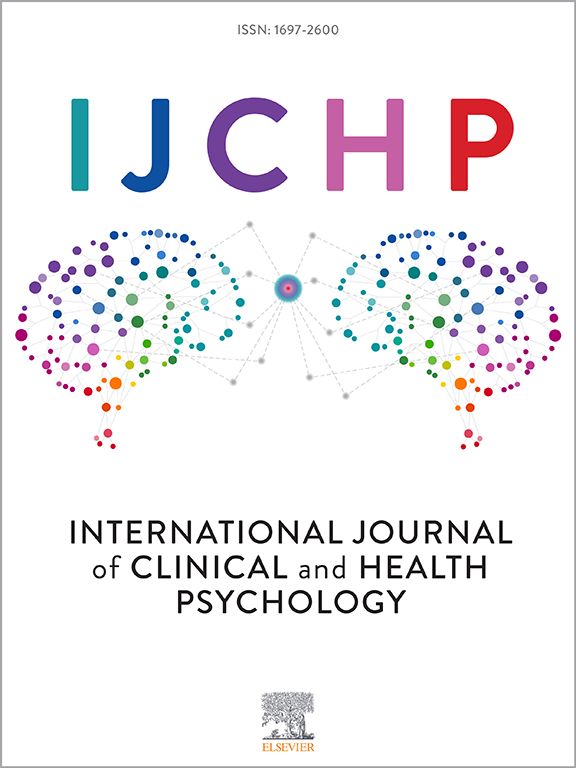Understanding body image in adolescents with drunkorexia behaviors: The roles of body image disturbance, coping strategies and gender
IF 5.3
1区 心理学
Q1 PSYCHOLOGY, CLINICAL
International Journal of Clinical and Health Psychology
Pub Date : 2025-04-01
DOI:10.1016/j.ijchp.2025.100584
引用次数: 0
Abstract
Drunkorexia consists of any calorie compensation or eating restrictive conduct enacted before, during, or immediately after alcohol intake. These behaviors raise many health concerns, but studies on adolescents are still limited. Specifically, understanding how body image impacts adolescent drunkorexia might be crucial for prevention and treatment. Following the multidimensional body image framework, this study investigated the role of various body image features (i.e., body image disturbance, adaptive and maladaptive body image coping) in explaining two types of drunkorexia behaviors in teenage girls and boys: (1) eating-related restrictive and compensative conducts; and (2) overexercising. The participants were 832 alcohol-drinking adolescents aged 15 to 20 years (48.6 % girls), who completed an online anonymous survey administered at school. A multigroup mediation model was estimated in line with the aims of the study. Body image disturbance symptoms were positively related to eating drunkorexia behaviors via the mediating effects of increasing maladaptive coping (avoidance and appearance fixing). However, the same relation was negative when the mediating effect of increasing adaptive coping (positive rational acceptance) was considered. Moreover, body image disturbance was positively associated with exercise-related drunkorexia behaviors via increasing appearance fixing coping. Finally, the indirect effect of body image disturbance on eating-related drunkorexia via appearance fixing was positive and significant only in girls (not in boys). These findings provide indications for implementing prevention and educational programs for schools, and for identifying core themes to address in clinical treatment and public health policies.
青少年醉酒行为中的身体形象:身体形象障碍、应对策略和性别的作用
醉酒包括在饮酒之前、期间或之后的任何卡路里补偿或饮食限制行为。这些行为引起了许多健康问题,但对青少年的研究仍然有限。具体地说,了解身体形象如何影响青少年饮酒症可能对预防和治疗至关重要。在多维身体形象框架下,本研究探讨了各种身体形象特征(即身体形象障碍、适应性和非适应性身体形象应对)在解释两类青少年醉酒行为中的作用:(1)与进食相关的限制性和代偿性行为;(2)过度锻炼。参与者是832名15至20岁的酗酒青少年(48.6 %为女孩),他们完成了一项在学校进行的在线匿名调查。估计了符合研究目的的多组中介模型。身体形象障碍症状与暴食行为之间存在正相关,其中介作用是适应不良应对(回避和固定外貌)的增加。然而,当考虑到增加适应性应对(积极理性接受)的中介作用时,同样的关系是负的。此外,身体形象障碍与运动相关的醉酒行为正相关,通过增加外表固定应对。最后,身体形象障碍对饮食相关的醉酒的间接影响是积极的,并且只有在女孩中显著(在男孩中没有)。这些发现为学校实施预防和教育计划提供了指示,并为确定临床治疗和公共卫生政策的核心主题提供了指示。
本文章由计算机程序翻译,如有差异,请以英文原文为准。
求助全文
约1分钟内获得全文
求助全文
来源期刊

International Journal of Clinical and Health Psychology
PSYCHOLOGY, CLINICAL-
CiteScore
10.70
自引率
5.70%
发文量
38
审稿时长
33 days
期刊介绍:
The International Journal of Clinical and Health Psychology is dedicated to publishing manuscripts with a strong emphasis on both basic and applied research, encompassing experimental, clinical, and theoretical contributions that advance the fields of Clinical and Health Psychology. With a focus on four core domains—clinical psychology and psychotherapy, psychopathology, health psychology, and clinical neurosciences—the IJCHP seeks to provide a comprehensive platform for scholarly discourse and innovation. The journal accepts Original Articles (empirical studies) and Review Articles. Manuscripts submitted to IJCHP should be original and not previously published or under consideration elsewhere. All signing authors must unanimously agree on the submitted version of the manuscript. By submitting their work, authors agree to transfer their copyrights to the Journal for the duration of the editorial process.
 求助内容:
求助内容: 应助结果提醒方式:
应助结果提醒方式:


